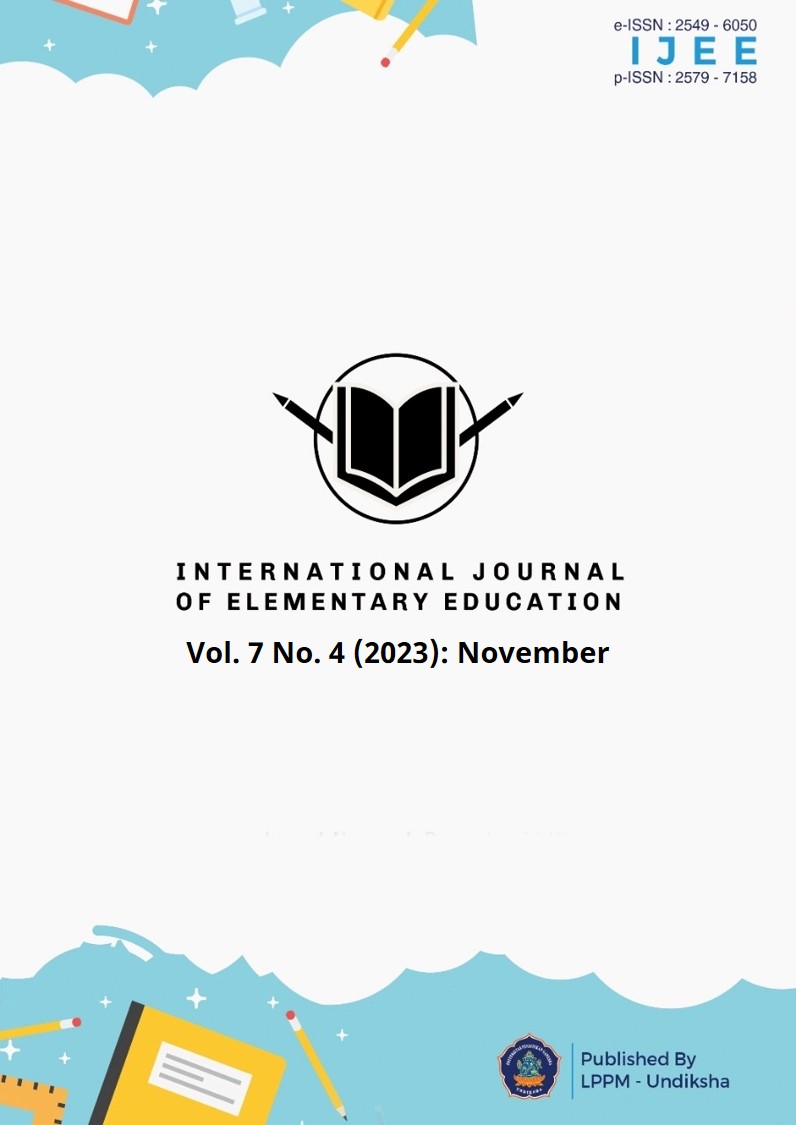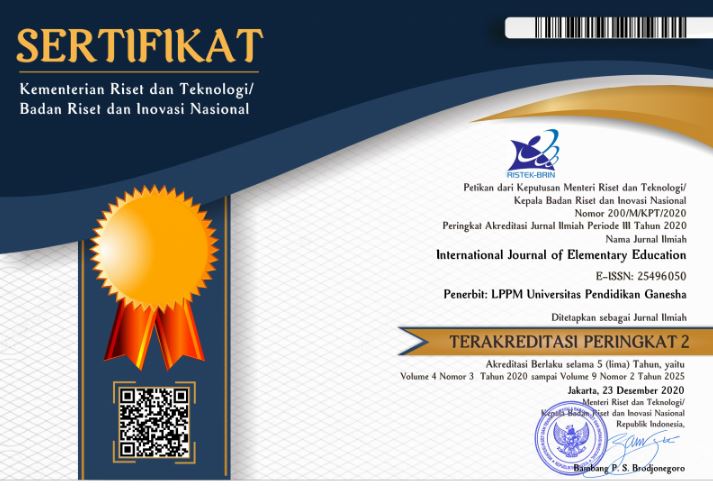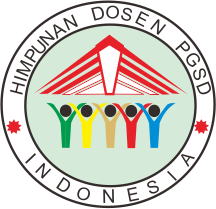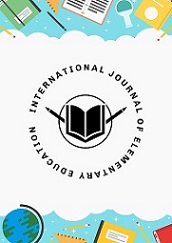Patterns of Computational Thinking Skills for Elementary Prospectives Teacher in Science Learning: Gender Analysis Studies
DOI:
https://doi.org/10.23887/ijee.v7i4.68611Keywords:
Computational Thinking, Elementary School, Teacher Prospectives, Science, GenderAbstract
The PISA data results show that computational thinking abilities are still lacking. Computational thinking ability is influenced by gender. This research aims to analyze patterns of computational thinking skills of prospective elementary school teachers based on gender at 8 universities in Indonesia. In this research, the components of computational thinking skills analyzed are abstraction, algorithmic, decomposition, and pattern recognition. This research is a mix method research with research subjects as many as 234 prospective elementary school teachers at 8 higher educational institutions. The instruments used were test and interviews. The data analysis technique used is a quantitative data analysis technique using SEM PLS and for qualitative data analysis using miles and Huberman. The research results show that computational thinking skills are still low on the decomposition and pattern recognition components. Based on the SEM PLS test results, it shows that computational thinking abilities are related to gender. In general, the computational thinking ability of female students is slightly higher in all sub-indicators than men and there are differences in the pattern of computational thinking ability between male and female elementary school teacher prospective. The ability of prospective female elementary school teachers to answer in more detail and more structured, while the answers of male prospective teachers are shorter and less comprehensive. Recommendations for developing computational thinking skills by developing problem-based learning, contextual project-based learning and STEAM based learning.
References
Allen, D. G. K., & Caviola, E. T. S. (2022). The Impasse on Gender Differences in Intelligence : a Meta Analysis on WISC Batteries. Educational Psychology Review, 2543–2568. https://doi.org/10.1007/s10648-022-09705-1. DOI: https://doi.org/10.1007/s10648-022-09705-1
Ansori, M. (2020). Pemikiran Komputasi (Computational Thinking) dalam Pemecahan Masalah. Dirasah : Jurnal Studi Ilmu Dan Manajemen Pendidikan Islam, 3(1), 111–126. https://doi.org/10.29062/dirasah.v3i1.83. DOI: https://doi.org/10.29062/dirasah.v3i1.83
Aristawati, F. A., Budiyanto, C., & Yuana, R. A. (2018). Adopting Educational Robotics to Enhance Undergraduate Students’ Self-Efficacy Levels of Computational Thinking. Journal of Turkish Science Education, 15, 42–50. https://doi.org/10.12973/tused.10255a.
Atmatzidou, S., & Demetriadis, S. (2016). Advancing students ’ computational thinking skills through educational robotics : A study on age and gender relevant differences. Robotics and Autonomous Systems, 75, 661–670. https://doi.org/10.1016/j.robot.2015.10.008. DOI: https://doi.org/10.1016/j.robot.2015.10.008
Azizah, N. (2023). Penerapan Pembelajaran Ipa Berbasis Computational Thinking Materi Siklus Air Kelas V. Prima Magistra: Jurnal Ilmiah Kependidikan, 4(2016), 269–282. https://doi.org/10.37478/jpm.v4i3.2655. DOI: https://doi.org/10.37478/jpm.v4i3.2655
Azizah, N. I., Roza, Y., & Maimunah, M. (2022). Computational thinking process of high school students in solving sequences and series problems. Jurnal Analisa, 8(1), 21–35. https://doi.org/10.15575/ja.v8i1.17917. DOI: https://doi.org/10.15575/ja.v8i1.17917
Bilbao, J., Bravo, E., García, O., & Rebollar, C. (2021). Heliyon Study to fi nd out the perception that fi rst year students in engineering have about the Computational Thinking skills , and to identify possible factors related to the ability of Abstraction n Varela. Heliyon, 7(2). https://doi.org/10.1016/j.heliyon.2021.e06135. DOI: https://doi.org/10.1016/j.heliyon.2021.e06135
Budiarti, H., Wibowo, T., & Nugraheni, P. (2022). Analisis Berpikir Komputasional Siswa dalam Menyelesaikan Masalah Matematika Herlina. Jurnal Pendidikan MIPA, 12(4), 1102–1107. https://doi.org/10.37630/jpm.v12i4.752. DOI: https://doi.org/10.37630/jpm.v12i4.752
Chan, S., Looi, C., Kin, W., Huang, W., Seow, P., & Wu, L. (2021). Heliyon Learning number patterns through computational thinking activities : A Rasch model analysis. Heliyon, 7(May), e07922. https://doi.org/10.1016/j.heliyon.2021.e07922. DOI: https://doi.org/10.1016/j.heliyon.2021.e07922
Cheng, Y.-P., Lai, C.-F., Chen, Y.-T., Wang, W.-S., Huang, Y.-M., & Wu, T.-T. (2023). Enhancing student’s computational thinking skills with student-generated questions strategy in a game-based learning platform. Computers & Education, 49. https://doi.org/10.1016/j.tsc.2023.101337. DOI: https://doi.org/10.1016/j.compedu.2023.104794
Çiftçi, A., & Topçu, M. S. (2023). Improving early childhood pre-service teachers’ computational thinking skills through the unplugged computational thinking integrated STEM approach. Thinking Skills and Creativity, 49. https://doi.org/10.1016/j.tsc.2023.101337. DOI: https://doi.org/10.1016/j.tsc.2023.101337
Cortini, M. (2014). Mix-method research in applied psychology. Mediterranean Journal of Social Sciences. https://doi.org/10.5901/mjss.2014.v5n23p1900. DOI: https://doi.org/10.5901/mjss.2014.v5n23p1900
Darmayanti, R., Sugianto, R., & Muhammad, Y. (2022). Analysis of Students’ Adaptive Reasoning Ability in Solving HOTS Problems Arithmetic Sequences and Series in Terms of Learning Style. Numerical: Jurnal Matematika Dan Pendidikan Matematika, 6, 73–90. https://doi.org/10.25217/numerical.v6i1.2340. DOI: https://doi.org/10.25217/numerical.v6i1.2340
Dian, M., Easti, A., Maya, R., & Ariyanti, G. (2023). Analisis Kemampuan Komputasional Mahasiswa dalam Kegiatan Pembelajaran Trigonometri. Journal Of Educational Review And Research, 6(1), 13–20. https://doi.org/10.26737/jerr.v6i1.4409. DOI: https://doi.org/10.26737/jerr.v6i1.4409
Dilla, S. C., Hidayat, W., & Rohaeti, E. E. (2018). Faktor gender dan resiliensi dalam pencapaian kemampuan berpikir kreatif matematis siswa SMA. Jurnal of Medives, 2(1), 129–136. https://doi.org/10.31331/medives.v2i1.553. DOI: https://doi.org/10.31331/medives.v2i1.553
Durak, H. Y., & Saritepeci, M. (2017). Analysis of the relation between computational thinking skills and various variables with the structural equation model. Computers & Education. https://doi.org/10.1016/j.compedu.2017.09.004. DOI: https://doi.org/10.1016/j.compedu.2017.09.004
Fanny, A. M. (2019). Implementasi Pembelajaran Berbasis HOST Dalam Meningkatkan Kemampuan Analisis Mata Kuliah Pembelajaran IPS di Sekolah Dasar. Jurnal Pendidikan Dasar, 44–52. https://doi.org/10.21009/JPD.0102.05. DOI: https://doi.org/10.21009/jpd.v10i2.13314
Haseski, H. I., Ilic, U., & Tugtekin, U. (2018). Defining a New 21st Century Skill-Computational Thinking: Concepts and Trends. International Education Studies, 11(4), 29. https://doi.org/10.5539/ies.v11n4p29. DOI: https://doi.org/10.5539/ies.v11n4p29
Kamil, R., Imami, A. I., & Abadi, A. P. (2021). Analisis kemampuan berpikir komputasional matematis Siswa Kelas IX SMP Negeri 1 Cikampek pada materi pola bilangan. AKSIOMA: Jurnal Matematika Dan Pendidikan Matematika, 12(2), 259–270. https://doi.org/10.26877/aks.v12i2.8447.
Konstantinidou, E., & Scherer, R. (2022). Teaching with technology: A large-scale, international, and multilevel study of the roles of teacher and school characteristics. Computers & Education, 179, 104424. https://doi.org/https://doi.org/10.1016/j.compedu.2021.104424. DOI: https://doi.org/10.1016/j.compedu.2021.104424
Korkmaz, O., Cakir, R., & Ozden, Y. (2017). A validity and reliability study of the Computational Thinking Scales (CTS) Özgen. Computers in Human Behavior. https://doi.org/10.1016/j.chb.2017.01.005. DOI: https://doi.org/10.1016/j.chb.2017.01.005
Kumala, F. N., Ghufron, A., & Pujiastuti, P. (2022). Elementary School Teachers’ TPACK Profile in Science Teaching Based on Demographic Factors. International Journal of Instruction, 15(4), 77–100. https://doi.org/10.29333/iji.2022.1545a. DOI: https://doi.org/10.29333/iji.2022.1545a
Kusumaningsih, Saputra, H. ., & Aini, A. . (2019). Cognitive style and gender differences in a conceptual understanding of mathematics students. MSCEIS, 0–6. https://doi.org/10.1088/1742-6596/1280/4/042017. DOI: https://doi.org/10.1088/1742-6596/1280/4/042017
Latifah, S., Diani, R., Lusiana, S., & Malik, M. (2022). ICARE Model ( Introduction , Connection , Application , Reflection , Extension ) in Physics Learning : Analysis of its Effect on Students ’ Computational Thinking Skills based on gender. 8(2), 229–240. https://doi.org/10.21009/1.08205. DOI: https://doi.org/10.21009/1.08205
Lee, Tak Yeon, M. L., Mauriello, June Ahn, A., & Bederson., B. B. (2014). CTArcade: Computational Thinking with Games in School Age Children. International Journal of Child-Computer Interaction, 2(1), 26–33. https://doi.org/https://doi.org/10.1016/j.ijcci.2014 .06.003. DOI: https://doi.org/10.1016/j.ijcci.2014.06.003
Lemay, D., Basnet, R. B., Doleck, T., Bazelais, P., & Saxena, A. (2021). Instructional interventions for computational thinking : Examining the link between computational thinking and academic performance. Computers and Education Open, 2, 100056. https://doi.org/10.1016/j.caeo.2021.100056.
Lemay, David, Basnet, R. B., Doleck, T., Bazelais, P., & Saxena, A. (2021). Instructional interventions for computational thinking : Examining the link between computational thinking and academic performance. Computers and Education Open, 2, 100056. https://doi.org/10.1016/j.caeo.2021.100056. DOI: https://doi.org/10.1016/j.caeo.2021.100056
Lestari, S., & Roesdiana, L. (2023). Analisis Kemampuan Berpikir Komputasional Matematis Siswa Pada Materi Program Linear. RANGE: Jurnal Pendidikan Matematika, 1(2), 178–188. https://doi.org/10.32938/jpm.v4i2.3592. DOI: https://doi.org/10.32938/jpm.v4i2.3592
Marchelin, L. E., Hamidah, D., & Resti, N. C. (2022). Efektivitas Metode Scaffolding Dalam Meningkatkan Kemampuan Berpikir Komputasi Siswa SMP Pada Materi Perbandingan. Jurnal Pengembangan Pembelajaran Matematika, 4(1), 16–29. https://doi.org/10.14421/jppm.2022.41.16-29. DOI: https://doi.org/10.14421/jppm.2022.41.16-29
Miles, M. B., Michael Huberman, A., & Saldaña, J. (2014). Qualitative data analysis: A methods Sourcebook (3rd Edition). In SAGE Publications, Inc. https://doi.org/10.1177/239700221402800402. DOI: https://doi.org/10.1177/239700221402800402
Pewkam, W., & Chamrat, S. (2022). Pre-Service Teacher Training Program of STEM-based Activities in Computing Science to Develop Computational Thinking. Informatics in Education, 21(2), 311–329. https://doi.org/10.15388/infedu.2022.09. DOI: https://doi.org/10.15388/infedu.2022.09
Qian, Y., & Choi, I. (2022). Tracing the essence: ways to develop abstraction in computational thinking. Educational Technology Research and Development. https://doi.org/10.1007/s11423-022-10182-0. DOI: https://doi.org/10.1007/s11423-022-10182-0
Rijke, W. J., Bollen, L., Eysink, T. H., & Tolboom, J. L. (2018). Computational Thinking in Primary School: An Examination of Abstraction and Decomposition in Different Age Groups. Informatics in Education, 1(17), 77–92. https://doi.org/10.15388/infedu.2018.05. DOI: https://doi.org/10.15388/infedu.2018.05
Riley, D., & Hunt, K. (2014). Computational Thinking for the Modern Problem Solver. CR Press. DOI: https://doi.org/10.1201/b16688
Sun, L., Hu, L., & Zhou, D. (2022). Programming attitudes predict computational thinking: Analysis of differences in gender and programming experience. Computers & Education, 181. https://doi.org/10.1016/j.compedu.2022.104457. DOI: https://doi.org/10.1016/j.compedu.2022.104457
Vourletsis, I., & Politis, P. (2022). Exploring the effect of remixing stories and games on the development of students ’ computational thinking. Computers and Education Open, 3(June 2021), 100069. https://doi.org/10.1016/j.caeo.2021.100069. DOI: https://doi.org/10.1016/j.caeo.2021.100069
Wing, J. (2006). Computational Thinking. Communications of the ACM, 49(3), 33–35. https://doi.org/10.1145/1118178.1118215. DOI: https://doi.org/10.1145/1118178.1118215
Yilmaz, R., Gizem, F., & Yilmaz, K. (2023). Computers and Education : Artificial Intelligence The effect of generative artificial intelligence ( AI ) -based tool use on students ’ computational thinking skills , programming self-efficacy and motivation. Computers and Education: Artificial Intel, 4. https://doi.org/10.1016/j.caeai.2023.100147. DOI: https://doi.org/10.1016/j.caeai.2023.100147
Yuntawati, Y., Sanapiah, S., & Aziz, L. A. (2021). Analisis Kemampuan Computational Thinking Mahasiswa Dalam Menyelesaikan Masalah Matematika. Media Pendidikan Matematika, 9(1), 34. https://doi.org/10.33394/mpm.v9i1.3898. DOI: https://doi.org/10.33394/mpm.v9i1.3898
Yunus, M., & Mitrohardjono, M. (2020). Pengembangan Teknologi di Era Industri 4.0 dalam Pengelolaan Pendidikan Sekolah Dasar Islam Plus Baitul Maal. Jurnal Tahdzibi: Manajemen Pendidikan Islam, 3(2), 129–138. https://doi.org/10.24853/tahdzibi.3.2.129-138.
Zhao, L., Liu, X., Wang, C., & Su, Y. S. (2022). Effect of different mind mapping approaches on primary school students’ computational thinking skills during visual programming learning. In Computers and Education (Vol. 181). https://doi.org/10.1016/j.compedu.2022.104445. DOI: https://doi.org/10.1016/j.compedu.2022.104445
Zhao, Y., Ding, Y., Shen, Y., Liu, W., & Trent, N. (2022). Gender Difference in Psychological , Cognitive , and Behavioral Patterns Among University Students During COVID-19 : A Machine Learning Approach. 13, 1–11. https://doi.org/10.3389/fpsyg.2022.772870. DOI: https://doi.org/10.3389/fpsyg.2022.772870
Downloads
Published
How to Cite
Issue
Section
License
Copyright (c) 2023 Farida Nur Kumala, Arnelia Dwi Yasa, Adam Bin Haji Jait

This work is licensed under a Creative Commons Attribution-ShareAlike 4.0 International License.
Authors who publish with the International Journal of Elementary Education agree to the following terms:
- Authors retain copyright and grant the journal the right of first publication with the work simultaneously licensed under a Creative Commons Attribution License (CC BY-SA 4.0) that allows others to share the work with an acknowledgment of the work's authorship and initial publication in this journal.
- Authors are able to enter into separate, additional contractual arrangements for the non-exclusive distribution of the journal's published version of the work (e.g., post it to an institutional repository or publish it in a book), with an acknowledgment of its initial publication in this journal.
- Authors are permitted and encouraged to post their work online (e.g., in institutional repositories or on their website) prior to and during the submission process, as it can lead to productive exchanges, as well as earlier and greater citation of published work. (See The Effect of Open Access)










